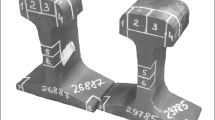Abstract
A technology of heat treatment of railroad rails using induction heating has been developed and installed in the Azovstal' metallurgical works. It provides the requisite combination of properties in the metal of rail heads. However, the metal of the web and the bottom of the rails remains in the initial (unhardened) state. Under severe operational conditions (small-radius curves, high axial loads, and composite configuration of the road) the wear resistance of the head and the structural strength of the web and the bottom not hardened in the plant have to be increased. The properties of the rail steel can be improved by alloying it using the most effective and available elements. Currently, in Ukraine this is manganese. The present paper is devoted to the effect of manganese additives on the phase transformations in induction hardening and the specific features of the formed structure and properties of the rail steel. Optimum parameters for heat treatment of rails are recommended.
Similar content being viewed by others
Author information
Authors and Affiliations
Additional information
Translated from Metallovedenie i Termicheskaya Obrabotka Metallov, No. 12, pp. 7–10, December, 1998.
Rights and permissions
About this article
Cite this article
Degtyarev, S.I., Skoblo, T.S. & Sapozhnikov, V.E. A study and development of technology for surface induction hardening of railroad rails from low-alloy steel. Met Sci Heat Treat 40, 477–481 (1998). https://doi.org/10.1007/BF02468507
Issue Date:
DOI: https://doi.org/10.1007/BF02468507




